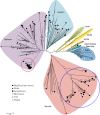Strong purifying selection in endogenous retroviruses in the saltwater crocodile (Crocodylus porosus) in the Northern Territory of Australia
- PMID: 23217152
- PMCID: PMC3531266
- DOI: 10.1186/1759-8753-3-20
Strong purifying selection in endogenous retroviruses in the saltwater crocodile (Crocodylus porosus) in the Northern Territory of Australia
Abstract
Background: Endogenous retroviruses (ERVs) are remnants of exogenous retroviruses that have integrated into the nuclear DNA of a germ-line cell. Here we present the results of a survey into the ERV complement of Crocodylus porosus, the saltwater crocodile, representing 45 individuals from 17 sampling locations in the Northern Territory of Australia. These retroelements were compared with published ERVs from other species of Crocodylia (Crocodilians; alligators, caimans, gharials and crocodiles) as well as representatives from other vertebrates. This study represents one of the first in-depth studies of ERVs within a single reptilian species shedding light on the diversity of ERVs and proliferation mechanisms in crocodilians.
Results: Analyses of the retroviral pro-pol gene region have corroborated the presence of two major clades of ERVs in C. porosus and revealed 18 potentially functional fragments out of the 227 recovered that encode intact pro-pol ORFs. Interestingly, we have identified some patterns of diversification among those ERVs as well as a novel sequence that suggests the presence of an additional retroviral genus in C. porosus. In addition, considerable diversity but low genetic divergence within one of the C. porosus ERV lineages was identified.
Conclusions: We propose that the ERV complement of C. porosus has come about through a combination of recent infections and replication of ancestral ERVs. Strong purifying selection acting on these clades suggests that this activity is recent or still occurring in the genome of this species. The discovery of potentially functional elements is an interesting development that warrants further investigation.
Figures


References
LinkOut - more resources
Full Text Sources

